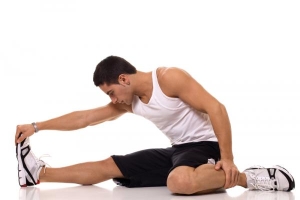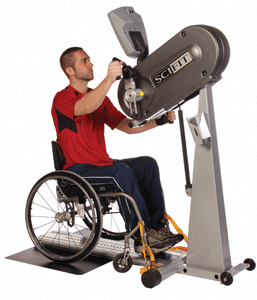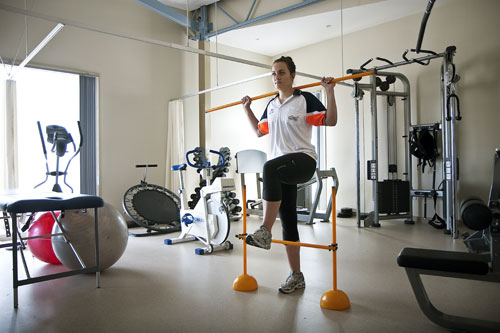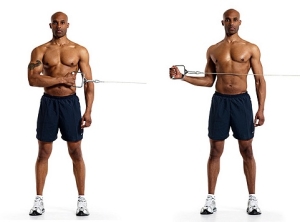Graduated exercise is used in rehabilitation to ensure exercise intensity and activities progress with healing and do not cause further injury. Graduated exercise refers to the gradual increase in range of motion, intensity, and activities to help ensure the athlete’s recovery is as pain free as possible. Graduated exercise will progress through three (3) stages – stretching, then conditioning, then total body fitness -, though these stages will overlap as the athlete recovers and is able to perform various activities.
Stretching as graduated exercise
There are various forms of stretching, including: static, proprioceptive neuromuscular facilitation (PNF), dynamic, and ballistic. Ballistic stretching is generally avoided in rehabilitation as it can be unsafe and cause injury by bouncing too far in the stretch causing a muscle strain. This is particularly unwanted in rehabilitation of a muscle strain.
 Static stretching is the least intense of the stretches, but also provides the least gain. Often graduated exercises of stretching begin with simple static stretches, before moving onto PNF and dynamic stretching.
Static stretching is the least intense of the stretches, but also provides the least gain. Often graduated exercises of stretching begin with simple static stretches, before moving onto PNF and dynamic stretching.
PNF stretching is the most common and usually the most beneficial form of stretching during rehabilitation. Gains in range of motion/movement are large, which helps prevent joint stiffness and promotes recovery.
Dynamic stretching is also used in rehabilitation, though usually towards the end as it requires more control. Usually an athlete who is using dynamic stretching has also progressed or graduated to the conditioning phase of rehabilitation.
Conditioning as graduated exercise
Conditioning is the process of strengthening muscles and getting them back to their pre-injury levels. This is in relation to muscular strength, muscular endurance, speed, and power. Muscles often lose these while an athlete is injured, especially if it is a muscular strain.
Conditioning is always specific to the injury, and the athlete involved. An injured knee will require conditioning of the muscles around the knee: hamstrings, quadriceps, and gastrocnemius. These muscles will need to be strengthened again as the reversibility effect would have caused atrophy in these unused muscles. Further loss will occur in muscular endurance and speed, and muscular strength combined with speed produces the muscular power.
Graduated conditioning of muscles begins with the strengthening of the muscles and developing muscular endurance. Exercises begin at low intensities and progressive overload is used to ensure the intensity slowly increases as muscular strength and endurance increase. Once the muscles as strong and can keep the joint stable to avoid further injury and they have their endurance back, muscular speed and power can also be redeveloped. These come last as they cause more stress to muscles and joints requiring a greater level of recovery.
Total body fitness as graduated exercise
 During injury the reversibility effect causes a loss of total body fitness. Some injuries result in an athlete being unable to exercise for extensive amounts of time, and reversibility begins after 2-3 weeks. If possible an athlete should be doing any exercise possible while injured. This could be upper body training, while the athlete recovers from an injured ankle, or lower body training if they have just had a shoulder reconstruction. Often it is possible for the athlete to do some forms of training while injured. Even exercising using the “good leg” when recovering form a knee injury on the other leg.
During injury the reversibility effect causes a loss of total body fitness. Some injuries result in an athlete being unable to exercise for extensive amounts of time, and reversibility begins after 2-3 weeks. If possible an athlete should be doing any exercise possible while injured. This could be upper body training, while the athlete recovers from an injured ankle, or lower body training if they have just had a shoulder reconstruction. Often it is possible for the athlete to do some forms of training while injured. Even exercising using the “good leg” when recovering form a knee injury on the other leg.
Regardless, this kind of training will only help slow down reversibility, and will not maintain previous total body fitness completely. This means the athlete will need to restore previous levels of fitness across their body. During this time pre and post injury testing becomes vital. Post injury test should be compared with pre-injury results to determine if the athlete has fully recovered or at least recovered to a level ready to return to play.
Total body fitness refers to each aspect of both the health and skill related components of fitness. This helps ensure a complete recovery in each component, so that no weakness is present when the athlete returns to play after graduated exercise.


